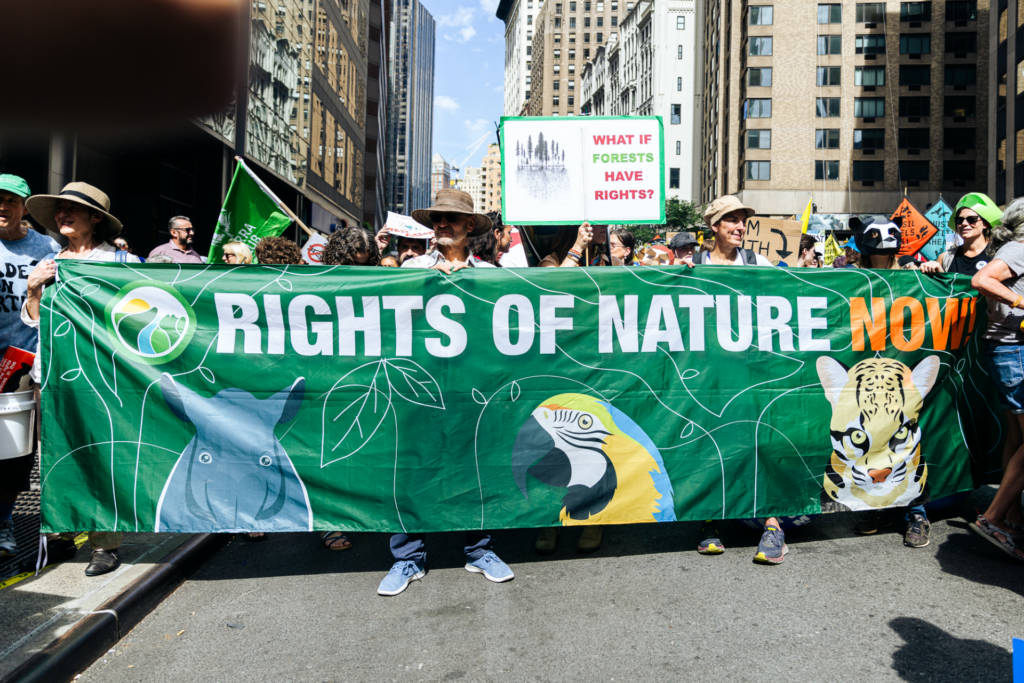Six Things to Know about Rights of Nature
More than 500 Rights of Nature laws and policies have been passed globally. Here’s how to make sense of this nascent movement — or movements.

This Fall, I have been co-teaching a course on Rights of Nature with the historian Jill Lepore. This is the first time either of us have taught the subject and it has proven a wonderful opportunity to explore with our students this emerging movement — one that some have praised as “A Legal Revolution That Could Save The World” and others decried as “A Wrong Turn” or worse. One thing is for sure — there is huge student interest in the topic. We had large waitlists from both law and college students. The student magazine ran a feature article because of the buzz around campus.
Here are the six main takeaways I have from the experience.
There is a there, there, but not so much in the United States.
There have been over 80 Rights of Nature (RoN) laws passed across the U.S., all at the local level. This is an impressive number, except… None has been successfully upheld when challenged in the courts. Not one. Cases have been tossed on vagueness, due process, and other grounds. An attorney in Colorado raising the claim that the Colorado River should have legal personhood was threatened with FRCP Rule 11 sanctions by the state Attorney General’s office. Given this record, it’s no surprise that RoN has been criticized as a failed legal strategy.
So, is there not much more to say? In fact, despite this uniform rate of failure, there is a lot worth saying. For starters, RoN is fundamentally a place-based movement, and its places of greatest impact happen to be outside the United States, in countries ranging from Ecuador, India, New Zealand, and Spain to Colombia, Canada, Bangladesh, and Australia, among others. In all, there have been over 500 RoN laws, cases, policies and declarations around the globe, and the numbers are increasing.
Rights of Nature is as much a strategy as a movement.
Calling RoN “a movement” may be misleading. Yes, there is a common strategy of granting natural bodies some kind of legal personhood, but beyond that, all bets are off. The reason is that these are mostly bottom-up initiatives in very different settings.
Each example only makes sense if you know the local history. While the Community Environmental Legal Defense Fund (later splitting into the Center for Democratic and Environmental Rights) have played key roles in some of the stories, the motivation for a RoN approach, its structure, and ultimate impact vary from place to place. RoN initiatives in Ecuador (which relies on courts applying a constitutional amendment) look nothing like those in New Zealand (which relies on national legislation settling land disputes with Māori groups) or in Spain (which relied on a local petition leading to national legislation).
As a result, I have become wary of writings that address RoN as a singular noun or the assumption that any particular people or writings speaks for RoN. As with any ambitious, emerging, and diffuse legal strategy, those involved are motivated by different interests and seek different goals. They choose different models and have different metrics of success.
Two basic RoN strategies have emerged, but most academic focus has been on litigation.
Most RoN scholarship focuses on lawsuits. Given the influence of Christopher Stone’s seminal article, “Should Trees Have Standing?” this isn’t surprising. Stone’s emphatic, “Yes!”, has provided a model for litigators to sue on behalf of natural objects. If you take this approach seriously, it poses a lot of challenges. Who should speak for the trees? How can we know what a forest really wants? What about res judicata? Should separate lawsuits be allowed for every tributary to a river? The troubling list can go on, as many law professors have persuasively argued.
There are answers to these challenges and it makes for a robust and important debate. The problem is that focusing on the challenges of litigation risks overlooking the second RoN strategy, one that may prove much more important in the USA over time — RoN through Governance.
Some of the best known RoN cases have been in New Zealand and Spain, and neither relies primarily on a litigation strategy. Instead, national legislation has created a governance structure for a forest, river, and lagoon. In Mar Menor, a lagoon in the southeastern corner of Spain, a petition signed by over 650,000 people led the Congress to pass a bill creating a series of bodies that have legal authority to act on behalf the lagoon. A Committee of Representatives composed of national and community officials as well as representatives from the NGO that sponsored the petition may propose actions and supervise compliance. They work with a stakeholder Monitoring Commission and Scientific Committee. New Zealand created a similar structure to manage Te Urewara National Park and the Whanganui River, with the key difference that some positions on the groups are held for members of the local Māori group. In these examples and others, the main focus is on a management plan rather than court-ordered remedies.
When one hears law professors arguing over the litigation challenges of RoN, this can give a misleading impression. To be sure, they have a point. RoN litigation in the US will prove difficult over the short- to medium-term, maybe even longer. But focusing on the courtroom risks obscuring that RoN as a governance strategy may prove more influential in the US context.
In both New Zealand cases, there was an impasse with the Māori communities demanding ownership and the government refusing to hand over public lands. The master stroke was a compromise where both government and Indigenous groups agreed that the contested areas could own themselves. This cleverly bypassed the conflicting positions and directed the focus to governance structures. Indeed, one could imagine this version of RoN serving as a model in future co-governance agreements with Native Americans.
Indigenous Governance
I knew this going into the course but still have been struck by the critical role that Indigenous groups have played in establishing the most effective RoN laws and rulings around the globe. New Zealand, which I mentioned above, provides a case in point.
Māori communities have lived by the Whanganui River for over 700 years. Disputes with the English over management of the river system date from the very first colonial settlements in 1840. A claims settlement process in the 1970s jump-started discussions that resulted in the Whanganui River Claims Settlement Act 2017. By this law, the government granted legal personhood to the Whanganui River and legal title to its property. The local Māori community plays a central role in the governance scheme that resulted. A similar series of developments played out with the Māori living in the Te Urewara National Park.
In Ecuador, which has followed more of a litigation strategy, a campaign led by Indigenous groups led to a constitutional amendment in 2008. This was the first country recognizing RoN. In Colombia, litigation over the Atrato River led to a Supreme Court decision recognizing RoN. The key groups behind the lawsuit were what the Court called Afro-Colombian and local Indigenous communities.
For these and many other Indigenous communities, regarding nature and the local environment as rights-bearing entities resonates with their worldview. One needs to be cautious in making generalizations, but the Enlightenment view of nature as an object of study or resource to be managed could not be more different.
The Unavoidable Lorax Problem
A key theme throughout our class has been what we call “The Lorax Problem” — “Who speaks for the trees?”
Whether granted by court or created by statute, in practical terms even more important than the granting of RoN is the challenge of who can or should act on behalf of the natural body’s interests. Why should a particular NGO bringing a lawsuit have any more legitimacy to speak than another group, much less propose remedies that vindicate the natural body’s RoN? In the Whanganui model, this issue is managed by entrusting two guardians of the river with detailed fiduciary duties to uphold the river’s status and protect the river’s interests as a living entity. One guardian is drawn from the local Māori communities and the other a government representative.
But, even here, the challenge remains. Neither the interests of the local Māori nor of the government representative are truly identical to the river. Maybe this is easy in extreme cases such as clear-cutting. But those are rare. Should any and all pollution be prohibited? What about diversions for irrigation? How much pollution and diversion is enough? These pose fundamental issues for traditional environmental law. A RoN approach does not and cannot avoid this line-drawing of how much is too much, either.
Measuring Success
As any lawyer knows, what is written in the regulation may have little bearing on what happens on the ground. Some RoN laws look like virtue signaling. Others may be well-intentioned but infeasible. In our last class, a number of students asked, “But does it work?” As with RoN itself, there is no single answer.
For one thing, RoN initiatives are young. The New Zealand cases date from less than a decade ago. The Mar Menor case in Spain was just upheld by the Supreme Court last month. It’s going to take time to see how these and the other initiatives play out.
Second, it may be a mistake to focus only on courtroom verdicts. In this regard, consider the example of the Lake Erie Bill of Rights (LEBOR). Frustrated by years of algal blooms and drinking water emergencies, residents of Toledo collected over ten thousand signatures to trigger a 2019 special election that LEBOR. Passed with over 60% of the vote, LEBOR became part of Toledo’s City Charter. LEBOR granted legal rights to Lake Erie and its watershed, which would now “possess the right to exist, flourish, and naturally evolve.” LEBOR also stated that corporations charged with a violation would not be legal persons and could not assert any defenses against the law. Nor, the new law stated, did the state of Ohio have the right to take any actions that would violate the rights established by LEBOR. Not surprisingly, LEBOR was quickly struck down in federal court, with the admonition that LEBOR was a “textbook example of what municipal government cannot do.”
This was a clear failure in the court of law, but around the same time as the decision, the governor announced the launch of H2Ohio, a funded water quality initiative that (surprise surprise) focused early on the Toledo watershed. The lawyers behind LEBOR must have known it was likely to be struck down. In other words, RoN laws will face serious challenges in US courtrooms, but that may not be where the action is. There is an argument to be made that RoN initiatives can succeed in the court of public opinion despite failure in the court of law.
So, what’s the take-home message? In addition to the six above, in keeping with the holiday spirit, here are three more stocking stuffers:
- By any measure, the explosion of interest in RoN forces environmental law to sit up and take notice. Dismissing it merely as hyperbole, the latest fad, or a way for local groups to fund raise is too easy. The phrase, “Rights of Nature,” holds a rhetorical power. It makes an intuitive and emotional connection with the need, with the responsibility, to protect our natural world that environmental law simply does not. It’s an approach that excites people. Nor is it going away.
- The impacts of climate change and loss of biodiversity are getting worse. The younger generations are fed up. They are looking for new approaches. Ironically, the term’s very looseness and multiple unrealized potentials makes it all the more enticing.
- If one looks at the history of American environmental law, there have been several distinct periods — the conservation movement of the early 20th century, the environmental movement in the 1970s, environmental justice starting in the 1980s, partisanship and polarization from the 1990s, and gridlock through today. What has made this course especially exciting to teach has been the impossibility of knowing if RoN is simply a fad that will soon pass. Or, perhaps, 10 or 15 years from now we will look back at what proved to be the beginnings of the Rights of Nature period.
Reader Comments
3 Replies to “Six Things to Know about Rights of Nature”
Comments are closed.







Dear Jim: Congratulations to both you and Jill for your remarkable innovations in teaching your rights of nature course at Harvard. I was thrilled to witness your students debating at the State House this past week. It’s the hands on learning as the various representatives of Nature that will open the door to the change in consciousness this movement requires. I really look forward to following your work!
How can environmental movements frame their cases to achieve success in the court of public opinion? Greeting : IT Telkom
The strategy is that by raising public support (either through a referendum or support for a lawsuit), the local community learns more about the threats to the river or forest, which makes political mobilization easier.